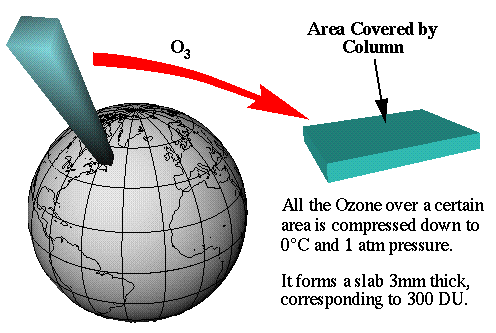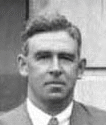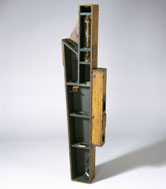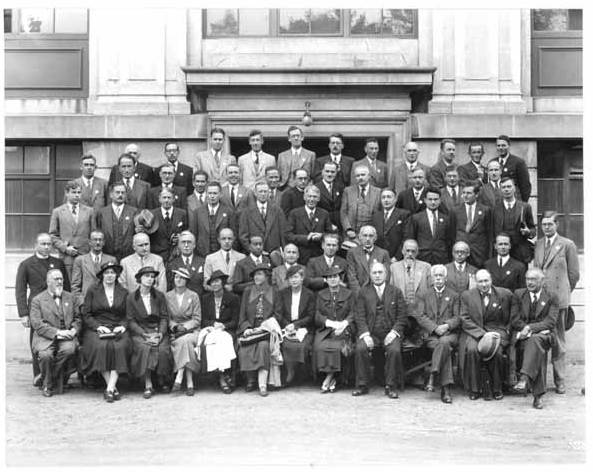|
Dobson Unit
A dobson unit is the most basic measure used in ozone research.One Dobson Unit (DU) is defined to be 0.01 mm thickness at STP (standard temperature and pressure). Ozone layer thickness is expressed in terms of Dobson units, which measure what its physical thickness would be if compressed in the Earth's atmosphere. In those terms, it's very thin indeed. A normal range is 300 to 500 Dobson units, which translates to an eighth of an inch-basically two stacked pennies.
In space, it's best not to envision the ozone layer as a distinct, measurable band. Instead, think of it in terms of parts per million concentrations in the stratosphere (the layer six to 30 miles above the Earth's surface).
The unit is named after G.M.B. Dobson, one of the first scientists to investigate atmospheric ozone .
G.M.B. Dobson 1936 G.M.B.Dobson (1889-1976) Dobson was an experimentalist of unusual ingenuity who devoted much of his life to the observation and study of atmospheric ozone. The results were to be of great importance in leading to an understanding of the structure and circulation of the stratosphere. He came to Oxford in 1920 to take up the position of University Lecturer in Meteorology, having previously been Director of the Experimental Department at the Royal Aircraft Establishment, Farnborough, during the War. Together Lindemann and Dobson worked on studies of meteor trails, from which they deduced that the temperature profile above the tropopause was not constant - as simple theory would predict and the name 'stratosphere' implies - but rather that there was a region where temperature increased substantially with height. Dobson inferred correctly that the cause of the warm stratosphere was heating by the absorption of ultraviolet solar radiation by ozone, and he set out to make measurements of the amounts and their variability. He decided to measure ozone by observing its absorption in the solar ultraviolet spectrum, as Fabry and Buisson had done a few years before. Dobson's first spectrograph employed a Fabry prism, an optical wedge consisting of gelatine and carbon black between quartz plates designed by T. Merton of the Clarendon Laboratory, and a filter consisting of a mixture of chlorine and bromine vapour to cut out unwanted solar radiation at longer wavelengths. A special tank was built to ensure consistent development of the photographic plates. To measure the line intensities Dobson built a photoelectric microphotometer using a potassium photocell, the current from which was measured by an electrometer also made in the Clarendon Laboratory.
In 1923 he produced the first Dobson Ozone Spectro-meter, to be succeeded in 1931 by his Spectrophotometer - a device which is still in use worldwide, with a network of over 150 instruments making daily observations. - the standard instrument used to measure ozone from the ground. The Dobson spectrometer measures the intensity of solar UV radiation. A single measurement uses two wavelengths of uv, but for normal operation pairs of readings are taken at two different wavelength settings for a total of four wavelengths, two of which are absorbed by ozone and two of which are not.
This group photograph is from the 'Second Ozone Conference' which was held in Oxford in September 1936 (the first was in Paris in 1929). The meeting attracted scientists from all over the world (16 different countries) who were working on or interested in atmospheric ozone. Dr Dobson, who was Reader in Meteorology in the Oxford University Physics Department, had done much of the pioneering work, and was the main organiser of the conference. 29 of the papers presented were published in a supplement to the November 1936 issue the Quarterly Journal of the Royal Meteorological Society, which even by today's standards represents very rapid action by the organisers and editor. (The University Library copy is date stamped 5 December showing that the issue was genuinely produced before then.) A report of the meeting by Dr A. R. Meetham was printed in the Meteorological Magazine for October 1936 (volume 71, pages 202-205). The next Ozone Conference was held in Brussels in 1951, under the auspices of the newly formed International Ozone Commission. Subsequent meetings were held in Oxford (1952), Rome (1954), Ravensburg (1956), Arosa (1961), Albuquerque (1964), Boulder? (1980), Thessaloniki (1984), L'Aquila (1996), Sapporo (2000). (See also Dobson, Applied Optics, 387-405, vol. 7 no 3, 1968.) Credit: Oxford University,NASA |









